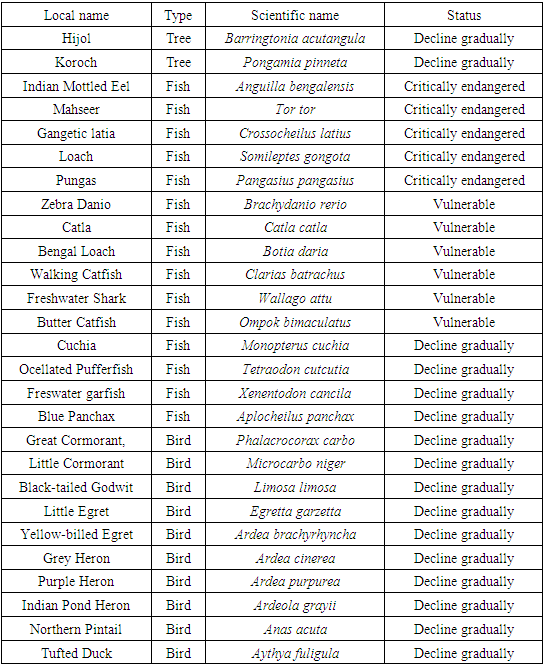-
Paper Information
- Paper Submission
-
Journal Information
- About This Journal
- Editorial Board
- Current Issue
- Archive
- Author Guidelines
- Contact Us
International Journal of Ecosystem
p-ISSN: 2165-8889 e-ISSN: 2165-8919
2022; 12(1): 20-30
doi:10.5923/j.ije.20221201.02
Received: Aug. 20, 2022; Accepted: Sep. 5, 2022; Published: Sep. 15, 2022

Impact of Environmental Pollution along with Technology for Conserving of Biodiversity
Jorin Tasnim Parisha 1, Md Rahimullah Miah 2, Md Mehedi Hasan 3, Motia Begum 4
1Government Satis Chandra (S.C.) Girls’ High School, Sunamganj Sadar, Sunamganj, Bangladesh
2Head, Department of IT in Health, North East Medical College affiliated with Sylhet Medical University, Sylhet, Bangladesh
3Assistant Professor, Department of Law, Green University of Bangladesh, Dhaka, Bangladesh
4Lawyer, Judge’s Court, Sylhet and Sunamganj, Bangladesh
Correspondence to: Jorin Tasnim Parisha , Government Satis Chandra (S.C.) Girls’ High School, Sunamganj Sadar, Sunamganj, Bangladesh.
| Email: |  |
Copyright © 2022 The Author(s). Published by Scientific & Academic Publishing.
This work is licensed under the Creative Commons Attribution International License (CC BY).
http://creativecommons.org/licenses/by/4.0/

Wetland biodiversity is a major area of environmental concern. Wetland biodiversity loss issues have been raised as an important national and global issue for many years due to lack of integrated policy, proper use of advanced technology, institutional support, political commitment and lack of relevant stakeholder involvement. The aim of the study was to assess the impact of environmental pollution associated with the conservation of biodiversity towards Tanguar Haor (TH). Its challenges are highlighted, including gaps in the core environmental protection tools and wetland management policy provided towards TH. Quantitative and qualitative environmental protection data were collected through preliminary surveys, field observations, interviews, focus group discussions, informal communication and feedback meetings, while secondary data were obtained from published journals and various relevant sources. The study shows that the conservation of wetland biodiversity policy amended was highest in Bangladesh between 2011 and 2020. Studies at the time showed that tourists were most likely to visit TH but that environmental awareness was low due to a lack of observation and the impact of traditional legislation. About 95% of respondents saw it as a more serious threat to environmental pollution due to food waste, rare dustbins, lack of environmental education, sudden landslides, uncontrolled use of polythene and wireless sensor technology, and poor publicity on social media. These results reflect the environmental conservation of biodiversity in TH that the state provides. The study assessed that the existing policy tools for protection of wetland biodiversity in Bangladesh are inadequate due to low priority given to policy integration, implementation and progress. Scientific knowledge is crucial in wetland biodiversity management but such knowledge is still below par and poorly identified. The study suggests a future research trajectory to a new alternative approach to promoting environmental policy options associated with the Ramsar Convention and Sustainable Development Goals 2030.
Keywords: Wetland, Tanguar Haor, Biodiversity, Stakeholder, Policy
Cite this paper: Jorin Tasnim Parisha , Md Rahimullah Miah , Md Mehedi Hasan , Motia Begum , Impact of Environmental Pollution along with Technology for Conserving of Biodiversity, International Journal of Ecosystem, Vol. 12 No. 1, 2022, pp. 20-30. doi: 10.5923/j.ije.20221201.02.
Article Outline
1. Introduction
- Biodiversity is in the vital field of environmental issues worldwide [1,2,3]. Human beings suffer a mixture of environmental issues day by day. The problem of losses of biodiversity has been raised as a very significant issue for several years [1,2,3]. Tanguar haor is a unique wetland biodiversity in Bangladesh. Its biodiversity has been familiar as an area of national and global importance exclusive attention [2,5,6]. Everyone exploits them but none can conserve them profoundly due to the lack of dynamic policy integration, advanced technological application, formal support and multi-stakeholder involvement [3,4,5,6]. Tanguar Haor is one of the largest natural freshwater wetlands in the north-eastern region of Bangladesh [8,10,11,12,18,19]. This haor is a wetland, which is very important for its huge and diverse aquatic population, fisheries and natural resources [19,20]. Realizing its importance in terms of national, regional and global ecology, its diverse biological resources, especially the habitat of large numbers of waterfowl and freshwater fish [20,21,22]. In addition to being globally important for its exceptional biodiversity, Tanguar Haor plays an important role in the economy of Bangladesh [18,25,27,28]. Tanguar Haor supports freshwater fish farming, provides livelihood directly to nearby villages, affords alternative income generations, and contributes greatly to the country's food production and security [28]. Tanguar Haor in Sunamganj is facing catastrophic loss of livelihood and biodiversity, which not only threatens the extinction of numerous species and unchanging genetic diversity, but also threatens food supply, health, safety and tourism [18,19,25,27,28]. The Tanguar wetland is experiencing rapid abnormal degradation over time along with the ecological imbalances [29]. This is because with every sudden landslide in the upper wetland area, houses, crop lands, biodiversity and surrounding water bodies are being buried under sand, rocks and pebbles in various ways and the environment is being polluted [30] with human interference.This study attempts to relook the environmental pollution that affects the aquatic biodiversity within and around the Tanguar Haor in Sunamganj district of Bangladesh.
2. Materials and Method
2.1. Study Site
- Tanguar Haor (TH) is located at Tahirpur upazila of Sunamganj district in Bangladesh, bordering the Indian state of Meghalaya [18], which map as shown in Figure 1. TH is a large haor spread over 10 mauzas of Dharmapasha and Tahirpur sub-districts of Sunamganj district [37]. The Tanguar Haor is the Ecologically Critical Area in Bangladesh, as a signatory to the Ramsar Convention [30]. The study followed different parameters including study site map (Figure 1), data collection, data compilation, analysis and interpretation are illustrated below.
 | Figure 1. Map of Tanguar Haor with study area in Sunamganj district of Bangladesh [30] |
2.2. Data Collection
- Quantitative and qualitative related environmental conservation data obtained through environmental base-line survey on flora and fauna including most affected site areas and visitors’ gathering, field observations, questionnaire surveys, interviews, key informant interviews, focus group discussions and informal discussion and feedback meeting while secondary data collected from diverse sources. The conservation policy related data collected from 1971 to 2020.
2.3. Data Compilation and Analysis
- A coherent and integrated methodological approach included advancing the research activities through data compilation and analysis for interpretation with updated software and tools, such as MS Office 2019, and SPSS- version27.
3. Results
3.1. Status of Environmental Concerns
- From the environmental base-line survey, the study identified following issues, which is being polluted the environment at Tanguar Haor along with the conserving of biodiversity, such as:(i) Throw food waste from visitors and others towards waterbody,(ii) Scarcity of dustbins adjacent visitor’s area,(iii) Lack of sufficient environmental Notice Boards in different places,(iv) Absence of awareness on environmental education programme, (v) Sudden landslides from bordering hills, (vi) Uncontrolled use of polythene among stakeholders,(vii) Excessive use of wireless sensor devices among visitors, tourist guide, co-management team leader and young generations,(viii) Poor publicity on mike announcing and social media.
3.2. Gender Status
- The study represents 52% of females and 48% of males out of total respondent including local people, tourist guide and visitors at Tanguar Haor, which as shown in Figure 2.
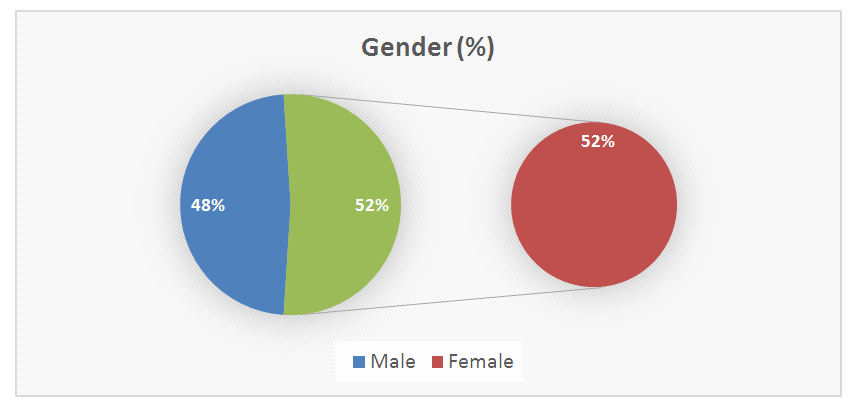 | Figure 2. Gender Status at Tanguar Haor |
3.3. District Wise Respondent’s Status
- The study show the visitors came to Tanguar haor from different districts, particularly 20% of Sylhet district, 15% of Sunamganj district, 18% of Habiganj district, 22% of Moulvibazar district and 25% visitors from other districts, which as shown in Figure 3.
 | Figure 3. District wise Visitor/Respondent’s Status |
3.4. Visit Status
- The study shows that the visitors’ visit status is approximately 87% of visit, which is maximum and revisit only 13%, which is minimum at Tanguar haor, which as shown in Figure 4.
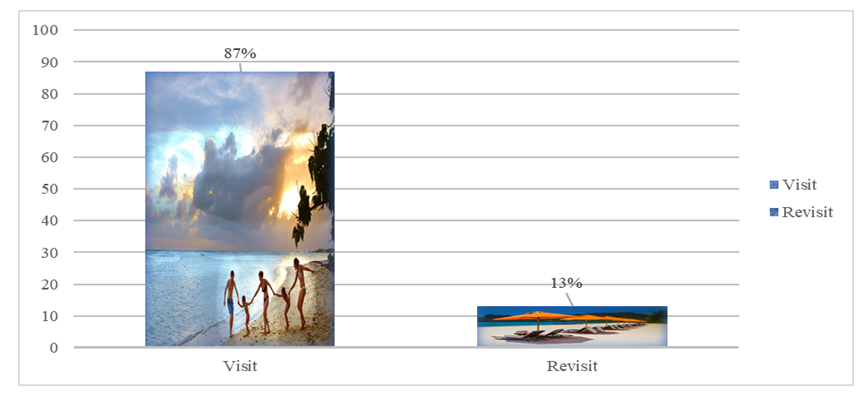 | Figure 4. Visitors’ Visit Status |
3.5. Respondents’ Age Status
- The study shows that the respondents’ age gradation is 31-40 years is maximum and above 71-80 is minimum, which as shown in Figure 5. The graph also represents the trend line.
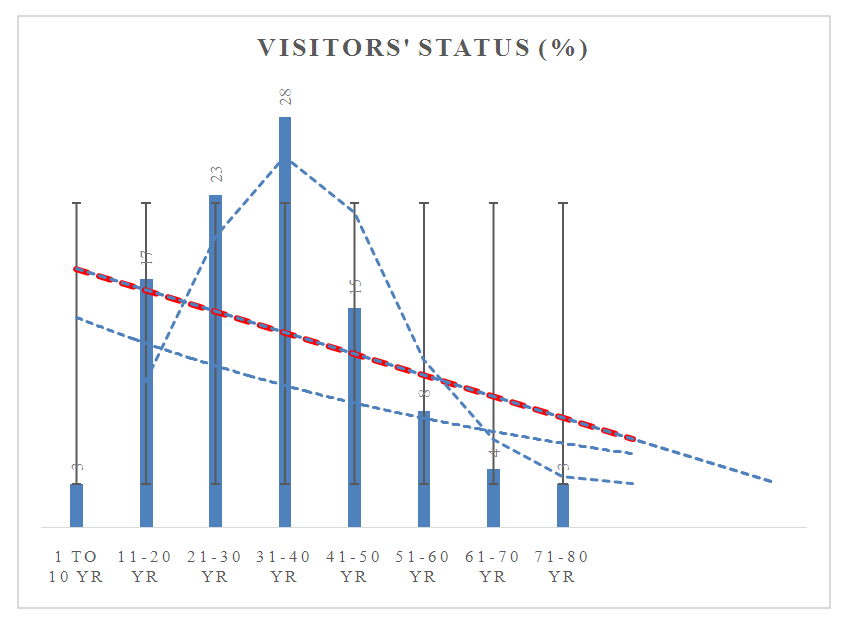 | Figure 5. Respondent’s age status at Tanguar Haor |
3.6. Species Diversity and Visitors’ Activity
- The study surveyed species including trees, fishes and birds, which as shown in Table 1 with local name, type, scientific name and present status. The status of these were declined gradually, some of them are critically endangered and vulnerable. The study shows that the visitors, cyber criminals, and other people are responsible to track the species with advanced wireless sensor technology for blocking and digital killing at a specific Global Positioning System (GPS), which as shown at Figure 7.
|
 | Figure 6. Perception on Pollution for Conserving of Biodiversity at Tanguar Haor |
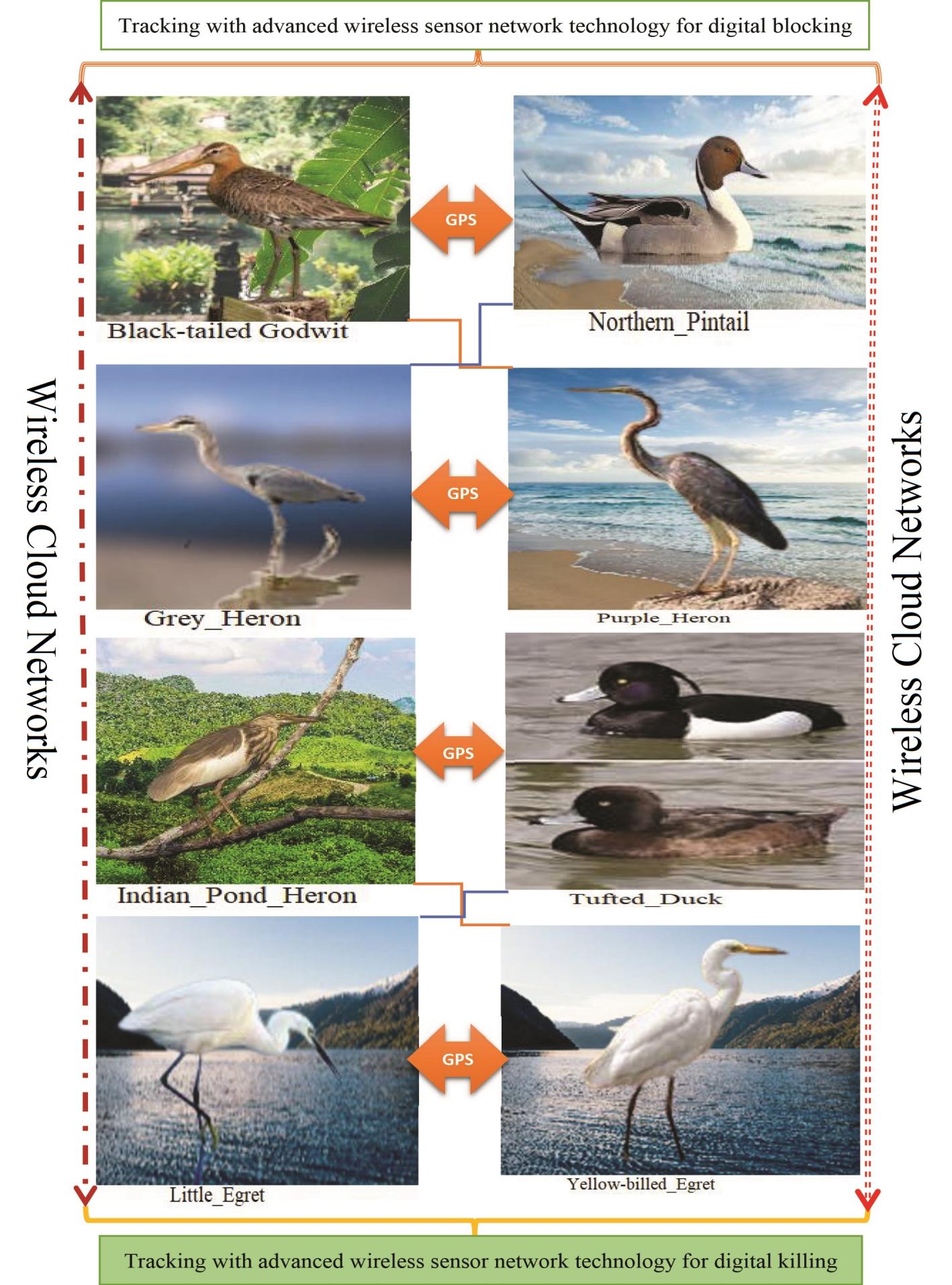 | Figure 7. Bird species at Tanguar haor, which are tracked by the visitors, cyber criminals and other persons with advanced wireless sensor technology at a specific GPS location |
3.7. Threat to Environment for the Conserving of Biodiversity
- About 95% of respondents saw it as a more serious threat to environmental pollution due to food waste, rare dustbins, lack of environmental education, sudden landslides, uncontrolled use of polythene and wireless sensor technology, and poor publicity on social media, which as shown in Figure 6.
3.8. Causes of Losses of Wetland Biodiversity
- From field survey, the study identified the root causes of losses of wetland biodiversity at Tanguar haor as listed (1) misuse of advanced wireless sensor technology, (2) Natural full causes, (3) Poisonous materials throwing, (4) Ecologically imbalanced, (5) Climate crisis, and (6) Unknown causes at night environment.The study also surveyed the opinions of respondents on the causes of sudden dead of fishes at Tanguar haor, which stated as followed: (i) Misuse of man-made wireless device 40% of respondents, (ii) Poisonous material and insecticides 28%, (iii) Due to fertilizers 15%, (iv) Natural death 11%, (v) Due to rotten materials 5%, and (vi) No idea 1%.
3.9. Formulation of Environmental Conservation Policy
- Tanguar Haor is an essential In-situ tool for biodiversity conservation with State policies. The study shows that the conservation of wetland biodiversity policy amended was highest in Bangladesh between the year of 2011 to 2020, which as shown in Figure 8.
 | Figure 8. Conservation Legislation of Bangladesh from 1971 to 2020 |
3.10. Inference
- Overall, the key conservation tools illustrated at the Tanguar Haor and its challenges with gaps in policies for wetland management highlighted. These results reflect the importance of conservation of biodiversity that the State provides. The study assessed that scientific knowledge is essential for wetland biodiversity conservation in Tanguar Haor, but such knowledge is below par and poorly identified. The study evaluated the existing conservation tool is inadequate for wetland biodiversity protection in Bangladesh due to lack of integrated policy, proactive participation, secure technology and protected GPS location of Tanguar haor.
4. Discussion
- The study was conducted to assess the environmental pollution along with conserving of biodiversity towards Tanguar Haor from an environmental and biological point of view, an impact assessment of the current multisectoral haor management system, and to compile an up-to-date list of fauna in different animal groups, including mollusks, fish, amphibians, reptiles, birds and mammals [27,30]. The overall study reveals that management interventions in Tanguar Haor with multi-field coordination led to significant changes in fish and waterfowl abundance. Huge fishes died in Tanguar Haor in 2017 due to misuse of wireless sensor technology at the fixed GPS locations [2].The Environmental Baseline Study of Tanguar Haor and the updated Environmental Conservation Status give an idea of the current state of wetlands in the northeastern part of the country and the habitat of animals. The study highlights the importance of preserving the environment of Tanguar Haor in a participatory co-management system for wetland management through advanced wireless sensor technology with Ramsar's intelligent-use policy in a sustainable manner [15,23].These results reflect the environmental conservation of biodiversity in Tanguar Haor that the state provides with wetland policy, rules, regulation and constitutional rights. But human interference, neglect and violence increase day by day for loss of biodiversity. The study assessed that the existing policy tools for protection of wetland biodiversity in Bangladesh are inadequate due to low priority given to policy integration, implementation and progress.
4.1. Research Innovation
- The study shows the following innovations to improve the management ecosystem of Tanguar Haor linking with the objectives of Ramsar convention, such as:(1) Creative thinking: The root cause of environmental pollution in Tanguar Haor has been identified due to misuse of advanced wireless sensor technology at a specific GPS location. (2) Cross-disciplinary collaboration: Authorities develop innovative ideas for scientific management of Tanguar haor through integrated policy adoption, public participation and secure technology activation.(3) Blue sky concept: Scientists and practitioners began to improve wetland conservation management by seeking one of the safest technological umbrellas possible. (4) Innovative culture: audience areas are segmented to prioritize wetland management practices with limited access to user wireless sensor devices. (5) Security development: Top administration is aware of establishing a wetland area network control unit for biodiversity restoration.
4.2. Novelty
- The research is unique with its novelties, such as: • Wireless sensor networks affect wetland biodiversity, which as shown in Figure 9.• Misuse of the advanced technology affects the entire wetland environment through Node Sensor or Distributed Sensor at a fixed GPS location.• It is the cause of deadly environmental pollution horrors due to unexpected loss of biodiversity. • Environmental crisis has exacerbated ecological weaknesses, social instability and widened economic inequalities.• Disrupted environmental law and policies due to infodemic phobia.
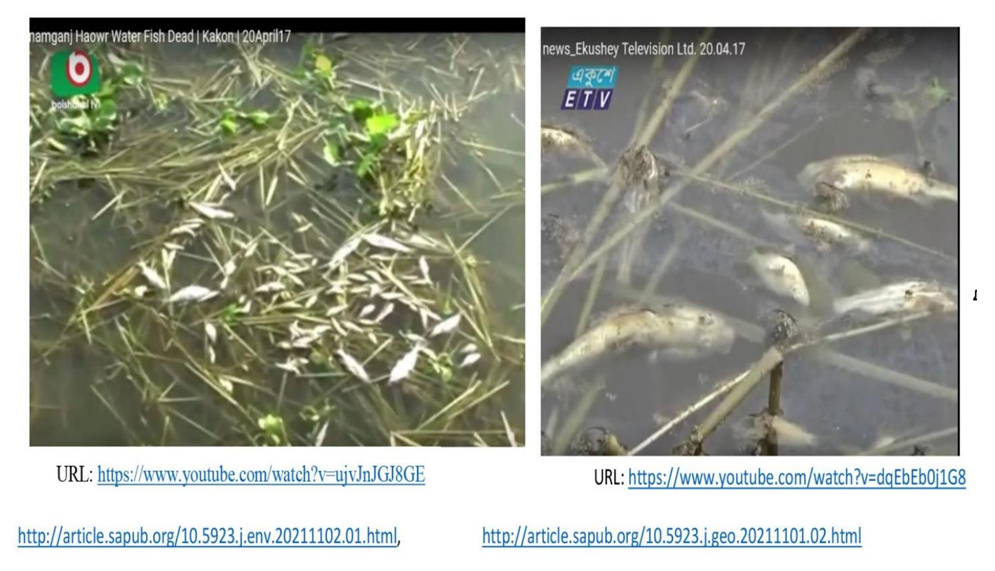 | Figure 9. Huge fish died in Tangua Haor due to misuse of wireless sensor networks |
4.3. Potentiality
- There are several potentials, which as shown as below:• It can improve security systems for wetland biodiversity conservation among Individuals, specialists, scientists, researchers and other stakeholders at national and global levels.• Experts have tried to implement ways to reduce the environmental pollution through alternative potentiality.• Long-term loss of biodiversity towards wetland can lead to challenge the target-oriented goals for Ramsar Convention and Sustainable Development Goals 2030. • Large potential on wetland biodiversity protection through motivation, research, servicing and access benefit share with Aichi Biodiversity Targets 2020.
4.4. Mysterious Technology to Destroy Wetland
- World Wetlands Day is being celebrated every year all over the world. The day is celebrated every year to raise awareness about the protection and conservation of wetlands. The day is being celebrated in Bangladesh keeping pace with the world. But with the help of pen on paper and technology, the day is being celebrated from one end of the world to the other. In reality, the condition of wetlands in any country of the world is not good. These wetlands are slowly disappearing from us due to the silent misuse of advanced wireless sensor technology. A lot of celebration, awareness programs and research continue. But people are still not aware of the hacking, tracking, hypnotizing and digital poisoning of cyber criminals [31,32,33,34]. When will the people of the world understand? When will people be aware? Will there be a proper secure network through misuse of technology? When will there be responsible tourist police in wetlands and places of interest? When will the UN control in-body GPS sensors and satellite networks? When will the results of accurate environmental research be accepted? And when will the evaluation be? With active open eyes in anticipation of this, the research looks forward to dynamic decision makers with sensor cameras. If the security systems fail in this wetland management, the people of the world and biodiversity will be severely damaged, then there will be no gain without regrets. Due to the lack of integrated policy and problematic wireless sensor technology, the misuse of ISNAH (Impact of Sensor Networks towards Animals and Humans) formula will increase tenfold. These include: (1) Cybercriminals who misuse wireless sensor technology will gradually reduce wetlands and agricultural lands, (2) Misuse of advanced technology will kill fish and other animals in ponds, reservoirs, rivers and seas, and fish farming will be disrupted. (3) Misuse of sensor technology will cause abnormally hot weather at night, (4) Humans and animals will feel uncontrollable cold during the day and will reverse day and night conditions. (5) Humans and animals will suddenly become ill, then die before being taken to a hospital or healthcare center. Cybercriminals use cloud wireless sensor devices to disrupt the flow of water, air and blood through digital poisoning. (6) Misuse of wireless sensor technology will cause sudden rain in selected areas and with that the sensor will cause sensor earthquake-tsunami-tidal-landslide-road accidents. (7) Misuse of high radio frequency devices will cause forest fires, ground fire, water fire and wildfire. (8) With the help of mobile sensor technology, cyber criminals will break down roads and bridges, and cut off local, national and international communications. (9) Cybercriminals will burn people, animals, birds, plants and objects with a sudden wireless sensor-fire, and burn ashes in the fires of technology in homes, shops, markets, buildings and industry. (10) Cybercriminals will wreak havoc on the sensor weather, climate and environment through the misuse of wireless sensor technology, resulting in severe damage to biodiversity everywhere. The researchers firmly believe that a small number of people will be safe from the misuse of advanced wireless sensor technology, who will know its proper use through my research. They hope that the concerned Ministries, Departments, Institutions and Agencies will take very accurate and acceptable measures to save the environment through wetland management.
4.5. Challenges
- There are several challenges for this scientific study on environmental concerns along with protection of aquatic biodiversity towards Tanguar Haor, such as: (i) limited time for data collection and interpretation, (ii) Unwanted phobia among respondents [16], (iii) Environmental diseases including Coronavirus disease pandemic [4,5,7,9,13,14,23], sudden cardiac arrest and onset respiratory disease- acute respiratory distress syndrome (ARDS) [31,32] (iv) visitor’s misusing of wireless sensor network [9,11,16] for creating unexpected climate crisis [1] and man-made technological heatwaves [35], (v) superstition among some stakeholders [17,24,26] during the period of interviews, and (vi) Laboratory test is rare in Sunamganj Sadar for flora and fauna species.
4.6. Future Research and Recommendations
- The study mentioned some recommendations for future research trajectories, such as:• Higher authority should take a dynamic security system to implement for long-term benefits of the advanced wireless sensor technology. • It’s of vital importance that visitors should use the right technology in the right place that is being introduced in their wetlands.• Should share the advanced applications of emerging technologies towards relevant research practices as a regular basis., particularly wetland areas to recover with DRAST (Disease Recovery through Advanced Wireless Sensor Technology [36].• Should improve sensor security systems in connection with national environmental policy and Sustainable Development Goals (SDGs) 2030.
5. Conclusions
- The study concludes that people are the main factor of all environmental problems while people are the effective solutions for nature conservation. The study enhances integrated awareness dynamic policy for healthy wetlands to resolve the global challenges of climate change, secure human health and biodiversity, and water security. The study suggests a future research trajectory to a new substitute approach to promoting environmental policy options associated with the Ramsar Convention, National Wetland Policy, Aichi Biodiversity Targets and Sustainable Development Goals 2030.
6. Declaration
- FundingThis research work is a part of Children’s Science Congress, which was presented at Congress on December 27-28, 2021 at virtual. The organizer provided to the presenter a Congress Award. The organizer had no role in the design of the research, in data collection, analyses or final interpretation of data, in the writings of the paper, or in the decision to publish the findings.Data AvailabilityThe data being used to support the findings of this research work are available from the corresponding author upon request. Competing InterestsThe authors declare no potential conflict of interests in this research work.
ACKNOWLEDGEMENTS
- The authors acknowledged the authority of Children’s Science Congress 2021, Bangladesh for providing the presentation support for the completion of this research work. The authors acknowledged the authority of Govt. SC Girls’ High School, Sunamganj, Government of People’s Republic of Bangladesh for kind support. The authors also acknowledged the higher authority of the Sunamganj District Office of Environment, Government of People’s Republic of Bangladesh, for the kind permission (verbal consent) of Survey and Data Collection at Haor Area.
Appendices
- Appendix-1: Questionnaireο 1. Visitor’s Name: ο 2. Age:ο 3. Gender:ο 4. Education Status:ο 5. Profession:ο 6. Family Member:ο 7. Own District:ο 8. Visit/Revisit:ο 9. Do you think new technology threat to environment: Yes/Noο 10. What are the causes of environmental pollution ?...................ο 11. How to overcome the existing pollution ?..................................ο 12. RemarksAppendix-2: Biodiversity related Environmental Conservation Laws and Policies
 | Appendix-2 |
 Abstract
Abstract Reference
Reference Full-Text PDF
Full-Text PDF Full-text HTML
Full-text HTML